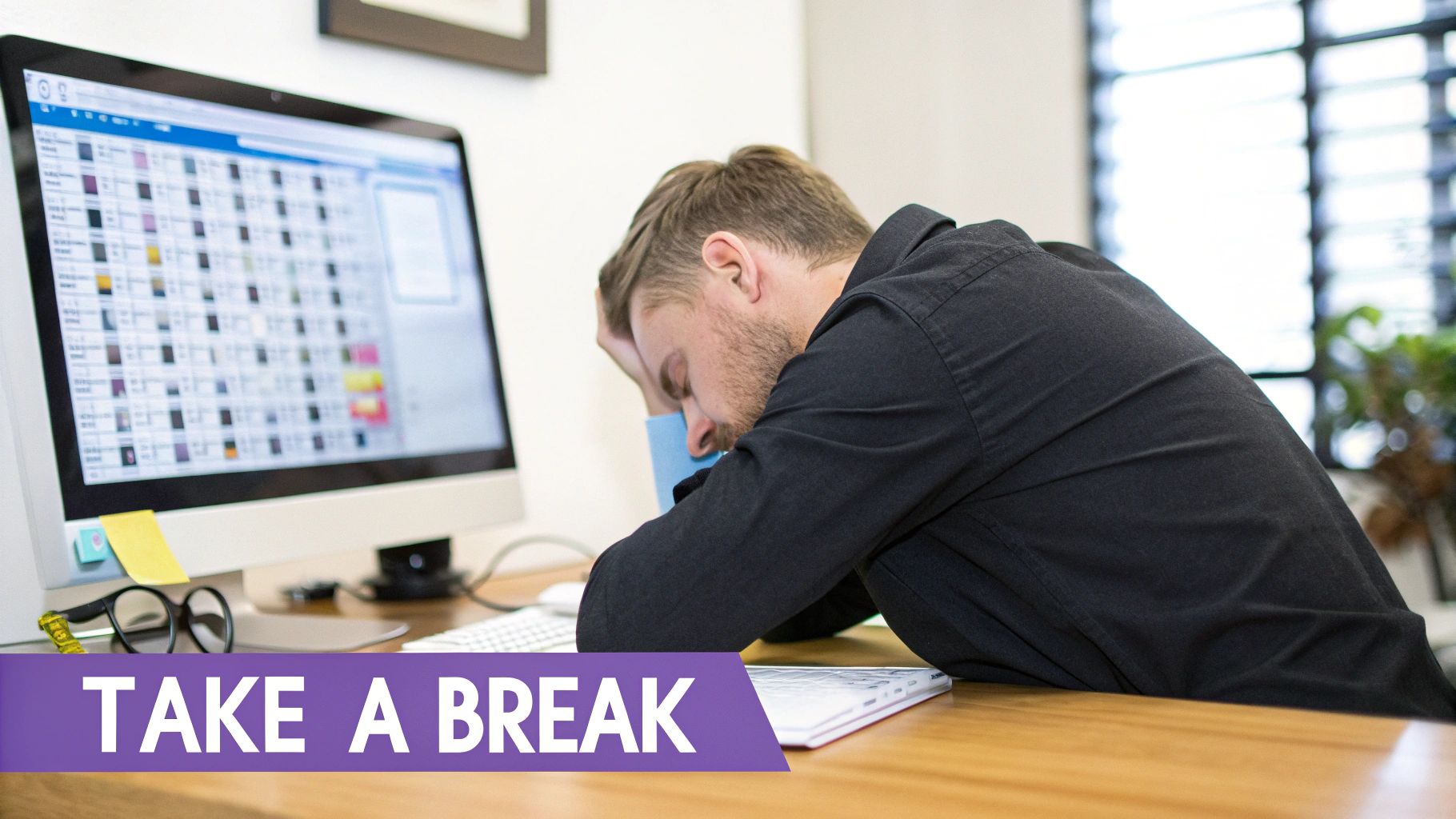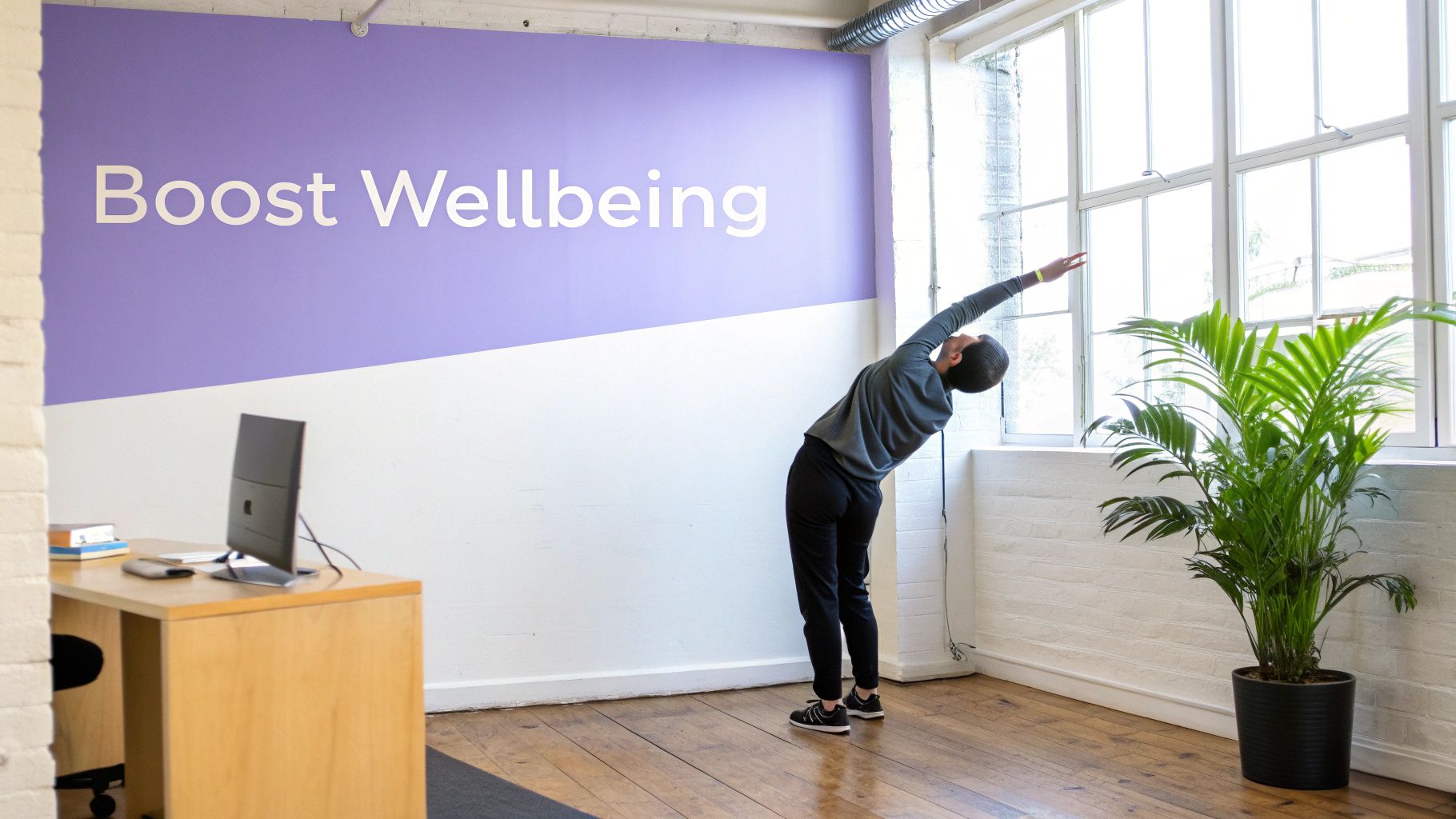Benefits of Taking Breaks at Work for Focus and Health
Discover the science-backed benefits of taking breaks at work. Learn how strategic pauses boost focus, prevent burnout, and improve overall wellbeing.
When you step away from your desk for a few minutes, you’re doing more than stretching your legs. You’re giving your brain a chance to recharge, which leads to improved productivity, better mental health, and reduced physical strain.
In fact, those short pauses can spark fresh ideas, sharpen your focus, and keep burnout at bay.
Why Chaining Yourself To Your Desk Is A Losing Strategy

We’ve all been there—eyes glued to the screen, mind wandering, frustration bubbling up. Modern work culture tends to lionize nonstop hustle, but that mindset actually backfires.
Think of your brain like a weightlifter’s muscles. If you try to lift heavy loads without giving yourself a break, performance slips and the risk of injury climbs. Your mind works the same way: relentless mental effort without rest causes your efficiency to plummet.
The True Cost Of Skipping Breaks
Skipping downtime doesn’t just leave you feeling wiped out. It chips away at your performance and well-being in ways you might not notice until you’re already running on empty.
Here’s what tends to happen on a no-break day:
- Decreased Productivity: Fatigue slows you down and invites mistakes. Studies show people who pause regularly actually get more done.
- Mental Exhaustion: Constant focus drains your cognitive reserves, making problem-solving and creative thinking far tougher.
- Increased Stress: Without a chance to decompress, stress hormones like cortisol stay high, nudging you toward anxiety and burnout.
- Physical Discomfort: Sitting for hours brings back pain, eye strain, and stiffness. Just standing up and stretching can ease these aches.
By reframing breaks as a strategic tool rather than a guilty pleasure, you unlock a more sustainable path to success. An intentional pause isn't a sign of weakness; it's a core component of peak performance.
This guide will explore the tangible benefits of integrating breaks into your routine. You’ll discover how these pauses can transform your workday from a grind into a focused, effective, and healthier experience.
How Breaks Recharge Your Brain’s Battery

Imagine your mind as a phone battery. Every email you reply to, every decision you weigh, chips away at that power bar. Eventually, you hit red and notice you’re slower, more prone to mistakes—classic attentional resource depletion.
Hitting pause isn’t slacking off; it’s like plugging in for a quick charge. Without those pit stops, you’re forcing your brain to slog along on empty, and the quality of your work takes a nosedive.
Overcoming Decision Fatigue
Each choice, big or small, nudges your mental meter closer to zero. By evening, even picking dinner feels like running a marathon—that’s decision fatigue in action.
A brief breather acts like a circuit breaker, cutting off the overload so you can come back refreshed. You’ll notice your next set of decisions lands with more ease and clarity.
A study by the American Psychological Association found that employees who took regular breaks reported better work quality and higher job satisfaction.
Activating Your Creative Network
Sometimes the best ideas bubble up when you’re not staring at a screen. Stepping away flips on your Default Mode Network (DMN)—your brain’s backstage crew for creative problem-solving.
Try these mini-break rituals to spark fresh insights:
- Take a Short Walk: Even a few laps around the block let your mind drift into new territory.
- Listen to Music: A non–work playlist breaks the mental loop and lifts your mood.
- Daydream for a Few Minutes: Look out the window, let thoughts wander, and watch connections form in the background.
By giving your brain room to roam, you’re not abandoning your to-do list—you’re fueling the breakthrough moments that make your work shine.
How Breaks Directly Fuel Your Productivity
It’s easy to fall into the trap of thinking that chaining yourself to your desk is the key to getting more done. We've all been there, pushing through fatigue, believing that stopping is a sign of weakness. But in reality, the most productive people I know have mastered the art of the strategic pause. They understand that breaks aren't about slacking off; they're about recharging for the next round.
Think of your focus like a muscle. If you try to lift weights for eight hours straight without a rest, you're not going to get stronger—you're going to get injured. Your brain works the same way. Trying to power through a full day without a break is a recipe for burnout and sloppy work. Breaks are the fuel stops that keep your mental engine running smoothly and efficiently.
Dodging the Dreaded Afternoon Slump
You know the feeling. It's 2:30 PM, your eyelids feel heavy, and reading the same email for the third time feels like an impossible task. That's the afternoon slump, and it's not a sign you're lazy—it's your brain telling you it's running on empty.
A short, intentional break is the perfect reset. Just a five-minute walk, a few quick stretches by your window, or even just stepping away to grab a glass of water can make a world of difference. This quick disengagement helps you return with a fresh perspective, turning what would have been a frustrating, low-output hour into a productive one.
This isn’t just a personal hack; it’s a critical strategy in today's economy. We're facing a weird productivity puzzle where working more hours isn't leading to better results. In fact, recent data shows that labor productivity growth in advanced economies has slowed to just 0.4%. You can learn more about this productivity slowdown on Chanty.com, but the takeaway is clear: we need to work smarter, and that starts with taking breaks.
Simple Frameworks for Getting in the Zone
One of the most powerful and well-known methods for building breaks into your day is the Pomodoro Technique. Don't let the fancy name fool you; it's an incredibly simple approach to managing your time and focus.
Here’s how it works:
- Focus on a single task for 25 minutes. No emails, no notifications, just pure focus.
- Take a short 5-minute break. Get up, walk around, do anything but work.
- Repeat this sprint-and-rest cycle four times.
- After the fourth round, reward yourself with a longer break—somewhere between 15 and 30 minutes.
The magic of this technique is that it trains your brain to operate in a rhythm of intense focus followed by deliberate rest. It proves that short, scheduled breaks are the key to unlocking long periods of deep, high-quality work.
When you start using a system like this, your mindset shifts. Breaks stop feeling like guilty interruptions and become the powerful tools they truly are. You're not just working longer; you're working smarter, producing better results, and building a much healthier relationship with your work in the process.
Your Practical Guide to Effective Break Strategies
https://www.youtube.com/embed/EBxV9YDEtAk
Knowing you should take a break is one thing, but knowing how is another game entirely. It turns out, not all pauses are created equal. A quick 60-second stretch and a 20-minute walk outside serve completely different purposes. The real secret to getting the most out of your downtime is matching the break to your specific need at that moment.
The best breaks are the ones that let you truly disconnect. It’s tempting to think that scrolling through social media counts as a rest, but you're often just trading one screen for another. Your brain never gets the complete time-out it's craving. The goal here is to genuinely step away and give your mind a chance to recharge its batteries.
Matching the Break to the Moment
Think of your break options like a toolkit. You wouldn't grab a hammer to tighten a screw, right? In the same way, the break you choose should fit the job. Are you trying to shake off screen fatigue, spark a new idea, or just find a moment of peace?
For instance, a micro-break—just a minute or two away from your screen—is the perfect antidote to eye strain. A longer walk, on the other hand, can do wonders when you're stuck on a tough problem, firing up the creative parts of your brain.
The quality of your break is so much more important than its length. Five minutes of intentional, screen-free rest will do you more good than 15 minutes of mindless scrolling.
When that afternoon slump hits and you’re not sure what to do, this decision tree offers a great place to start.

This visual drives home a simple but powerful point: when your energy is tanking, movement is one of the quickest ways back up. Even a brief walk can be enough to hit the reset button on both your mind and body.
A Framework for Different Needs
To build a break routine that actually sticks, it helps to know which type of break to pull out of your toolkit and when. Having a simple framework makes it much easier to stay consistent and really feel the benefits.
One of the most popular and effective methods is the Pomodoro Technique. It’s a simple cycle: you work in focused bursts (traditionally 25 minutes) and then take a short break. You can easily give it a try with a free online Pomodoro timer to see how the rhythm feels. It’s fantastic for keeping your concentration sharp over a long day.
To help you get started, here’s a quick comparison of different break types and when they work best.
Choosing the Right Break for Your Needs
| Break Type | Ideal Duration | Primary Benefit | Best For |
|---|---|---|---|
| Micro-Break | 30-60 Seconds | Physical Reset | Relieving eye strain or stretching out stiff muscles between tasks. |
| Short Break | 5-10 Minutes | Mental Recharge | Regaining focus after a period of intense concentration. |
| Long Break | 15-30 Minutes | Creative Boost | Solving a complex problem or generating new ideas. |
| Lunch Break | 30-60 Minutes | Full Recovery | Disconnecting completely, refueling, and socializing with colleagues. |
Ultimately, it all comes down to being more intentional with your downtime. By creating a personalized strategy that fits your workflow, you can turn breaks into a powerful tool. Listen to your body and brain—they’ll tell you when it’s time to step away. This proactive approach doesn't just make you more productive; it protects your well-being for the long haul, leading to a healthier and more sustainable way of working.
How Taking Breaks Enhances Your Wellbeing

Taking regular pauses isn’t just a trick to boost your output—it’s a deliberate act of self-care. By stepping away from your screen, you give both body and mind the chance to reset and recharge.
Think of yourself as a finely tuned machine. If you never stop for maintenance, parts start wearing out. Short breaks are the oil that keeps everything running smoothly.
An Antidote To Sedentary Work
Sitting for hours increases the risk of aches, pains, and more serious health issues. A handful of small, frequent pauses can dramatically reduce those risks.
- Reduce Eye Strain: Staring at a screen tires your eyes fast. Aim for the 20-20-20 rule: every 20 minutes, look about 20 feet away for 20 seconds.
- Alleviate Back and Neck Pain: A quick stretch gets blood flowing and eases tension in your shoulders, neck and lower back.
- Prevent Repetitive Strain Injuries (RSIs): Flex your wrists and fingers to ward off carpal tunnel and similar conditions.
Together, these simple habits build a strong foundation for long-term physical comfort.
A Pressure-Release Valve For Your Mind
Constant focus can leave you wired, stressed, and on the brink of burnout. Letting cortisol levels drop through mini-breaks is essential for staying calm and clear-headed.
Breaks function as a mental reset button. Stepping away from a challenging task lowers cortisol levels, eases feelings of anxiety, and significantly boosts your mood and overall job satisfaction.
Research shows that even micro-breaks drive up energy and cut fatigue. You can read the full research about break benefits at NCBI. And for deeper tips, explore our strategies for self-care and burnout prevention.
By carving out these pockets of downtime, you’re doing more than preventing exhaustion—you’re building a sustainable mindset. Dive deeper in our guide on how to avoid burnout at work to keep your well-being front and center.
Building A Work Culture That Encourages Breaks
Small habits turn into big wins when a team sees stepping away from the desk as smart, not slack. Leaders set the tone by taking regular pauses themselves. Building buffer time around meetings and openly supporting downtime gives everyone permission to recharge.
For Managers, Lead by Example:
- Take breaks in view of the team.
- Schedule meetings with built-in buffer time.
- Speak up whenever someone needs a breather.
Fostering A Supportive Environment
Healthy boundaries come from mutual respect. Colleagues can acknowledge each other’s need for a mental reset without guilt.
Even simple additions—like playing soft tunes—make a difference. 86% of people report higher productivity listening to music. You can discover more insights about productivity statistics on Clockify.me.
A culture that normalizes breaks isn't just about employee perks; it's about building a more resilient, engaged, and high-performing team. Everyone shares the responsibility for making it a reality.
To make breaks more inviting, think about rest-area upgrades. Offer comprehensive break room vending services for easy snacks and drinks.
Creating this supportive atmosphere is at the heart of any effective workplace wellness programs. When everyone feels free to step away and return refreshed, productivity naturally follows.
Answering Your Top Questions About Taking Breaks
You’re sold on the idea of taking more breaks, but now the practical questions kick in. How long should they be? What should you do during that time? And how do you shake that nagging feeling of guilt when you step away?
Let's dig into some of the most common questions people have when building a better break routine.
How Long Should a Work Break Be?
There isn't a single magic number here. The "right" break length really depends on what you're doing and how you're feeling. Think of it less like a rigid rule and more like choosing the right tool for the job.
A quick micro-break is perfect for shaking off screen fatigue, while longer breaks offer a more substantial mental reset.
- Micro-Breaks (30–60 seconds): These are fantastic for a quick physical reset. Blink, stretch your neck, or just look out the window to give your eyes a rest.
- Short Breaks (5 minutes): This is the sweet spot for a mental refresh. A 5-minute pause, like the one in the popular Pomodoro Technique, is just enough to clear your head and come back to a task with renewed focus.
- Long Breaks (15–30 minutes): Think of this as a full system reboot. It's enough time to completely detach, which is crucial for deep cognitive recovery and problem-solving.
The key is to match the break to the need. A short burst of intense focus might only require a micro-break, while a long, draining meeting definitely calls for a more substantial pause afterward.
What Should I Actually Do On My Break?
The most effective breaks are the ones that create a clean shift away from your work. The goal is to change your mental and physical state.
Getting up for a short walk, doing a few simple stretches, or just stepping outside for some fresh air can do wonders. A quick chat with a coworker about anything but work is another great way to spark some fresh energy.
Whatever you do, try to avoid swapping one screen for another or tackling a household chore that feels just like another task on your to-do list.
The best break is a true disconnect. It’s an activity that lets your work-focused brain switch off so it can actually recharge.
How Do I Stop Feeling Guilty About Taking a Break?
That feeling is surprisingly common. We're often conditioned to believe that being "busy" equals being productive. The first step is to reframe the break in your mind. It’s not slacking off; it's a strategic tool for better performance.
Start by scheduling them directly into your calendar, just like you would a meeting. Make them non-negotiable. Once you start noticing how much sharper and more creative you are after a real pause, that guilt will start to fade.
But What if I Just Power Through and Skip Them?
It might feel like you're gaining time, but you're actually setting yourself up for diminishing returns. Pushing through without a pause just slows you down and makes you more prone to mistakes.
Continuously working raises your body’s stress hormone, cortisol, which quickly drains your energy and tanks your mood. Consistent breaks are what allow you to maintain a high level of performance throughout the entire day, not just for the first couple of hours.
How Can I Make Breaks a Real, Lasting Habit?
Building a new habit takes a bit of intention. Set a timer on your phone or use a dedicated app to remind you.
Another great trick is to "stack" the habit onto something you already do. For example, decide to take a 5-minute break every time you finish a report or send off a big email. You can even track your break "streaks" to celebrate your progress and keep yourself motivated.
Treating your breaks as an essential part of your workflow is the secret. They're not a reward; they're a requirement for doing your best work.
Ready to safeguard your health and boost productivity? Try DeskBreak at https://www.deskbreak.app